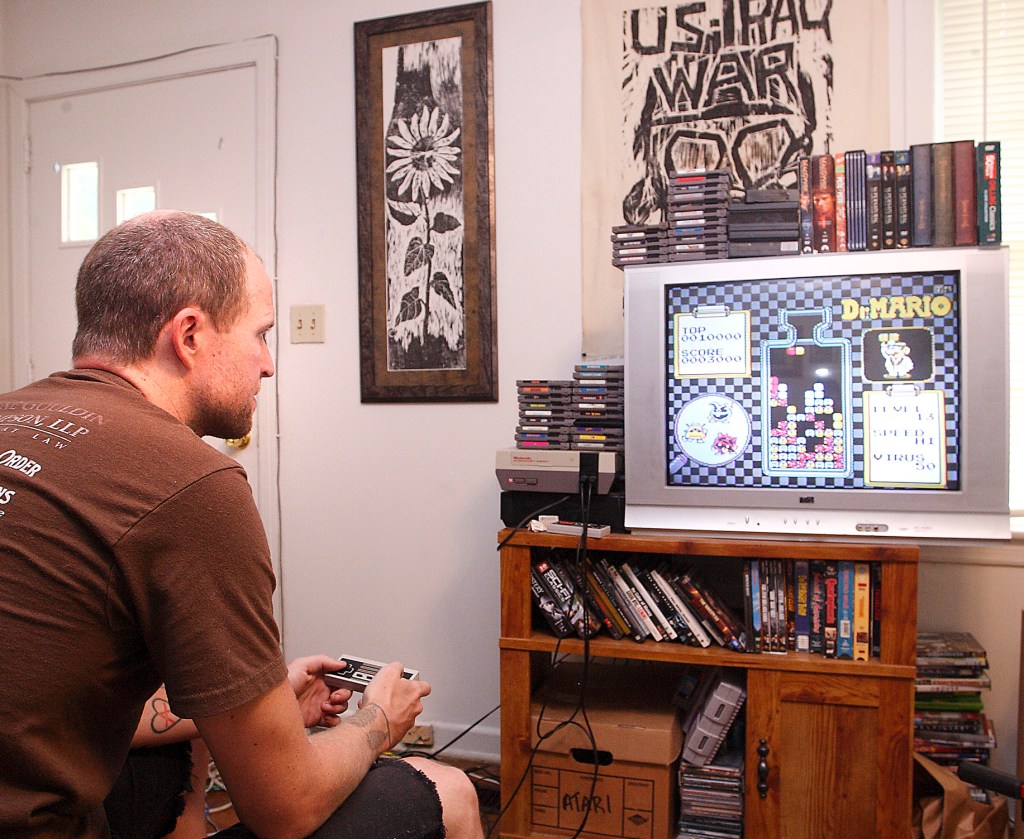Valdostan champions, innovates video games
Published 1:00 pm Monday, September 5, 2011

- Patrick Stanley plays Dr. Mario on his Nintendo Entertainment System in his living room. Stanley holds two verified world records in video games, one of them for Dr. Mario.
Without a doubt, video games have been one of the most significant entertainment mediums in America for the last 40 years.
Trending
It would be hard to find someone who has not played a video game. It might have been Super Mario Brothers on the original Nintendo Entertainment System during childhood. It could have been a mother who enjoyed playing Tetris or Solitaire in her spare time. Maybe a husband races home after work to play a couple games of Madden Football or Call of Duty to unwind.
Even though video games are by no means a recent phenomenon, they are rarely considered a career option.
Local Valdosta resident Patrick Stanley might disagree.
Stanley, 28, holds two verified world records in video games and has managed to turn his hobby into a lucrative business.
Last year, at the world’s largest arcade, Funspot, located in New Hampshire, Stanley shattered the records for Dr. Mario and Rampage, two popular arcade games from the late 1980s.
His high score on Dr. Mario, a puzzle game that requires players to match up similarly colored pills and viruses, is 1,739,700.
Trending
“There might be some guy in Southeast Asia that can beat both of these records but he hasn’t submitted yet,” said Stanley. “That’s the thing — you can go to a golf course and shoot a 50 tomorrow, but if it’s in practice and nobody sees it, then it doesn’t matter. You’ve got to do it with some sort of verification process.”
Rampage, a game that harkens back to the movie “King Kong,” requires players to guide either a giant gorilla, lizard or wolf humanoid
creature through cities with one purpose — destroy as much as possible. Stanley scored 542,335 in one sitting. A record, Stanley states, is three times the second-place score.
Video games have always been a big part of Stanley’s life.
He would play his Game Boy on the way to swim meets and would play the NES with friends, but it was not until he saw the documentary “King of Kong: A Fistful of
Quarters,” which follows the story of Steve Wiebe as he attempted (successfully) to break the Donkey Kong arcade record that he realized old video game records were chronicled.
“It’s not exactly accurate, but it’s documentary film-making at it’s best,” said Stanley. “They splice a lot of stuff, but made an amazing documentary.”
Stanley was in college when the movie came out and began playing the old-school games on his computer before he was able to save up a bit of money and buy the original systems and cartridges.
“I hate to admit it, but I spent at least a few thousand hours learning
the ins and outs of each game,” said Stanley. “Dr. Mario is one of those games where once you get to a certain point, the learning curve is huge — learning exactly how the scoring system works and how the combinations are performed.”
He explains the game is similar to Tetris in that the pills are not completely random in their appearance, which requires the player to take risks and think ahead for big scores.
Nick Meaks, a friend, showed Stanley how to really play. He had broken the record at a local arcade, but taught him a number of tricks he would improve upon for his own record attempt. Part of this meant looking at the game structure horizontally, which adds another dimension to the vertically aligned game.
For Rampage, he saw a bunch of activity at the machine at Funspot and decided to give it a chance at a local bar that he frequented.
“I played it as a kid, but never really got that good at it and never really liked it that much,” explained Stanley. “It was made to be a quarter eater, which really sucks if you want to play for a long time. As a kid, I could play Mrs. Pac-Man for 45 minutes on a quarter or Rampage for five minutes.”
After months of learning the algorithms and movements of the game, he called Richie Knucklez, owner of Funspot, who hosted an event called the “Tron-Off.” Knucklez hoped to have as many world records broken as possible, since the Guinness Book of World Records and Twin Galaxies would be present to verify the achievements.
“I called up Richie and told him I could break the record. He gave me 24-hour access for three days to break the record,” said Stanley. “I was the third record of the event.”
Currently, Stanley is working on breaking records for two less-popular games: Circus Charlie and Pooyan, a game where you play as a pig trying to save piglets from wolves that float down from trees on balloons.
“They’re not terribly popular games, but they’re games that I have fun with,” said Stanley. “If I’m going to invest time in learning a game and set a record, I’d rather it be a game that I enjoy than a big-name game. Even if it’s over 10 years, a thousand hours is a lot of time to invest into a game.”
For future records, he is working on Q-Bert and Satan’s Hollow.
Stanley never spent much time playing modern games.
“When systems started adding more buttons, it sort of complicated things in my head,” said Stanley. “There were these other games that I hadn’t mastered that have one button or no buttons. Why would I start adding more?”
Even though he has never played a Wii or the more modern games, he encourages people to play whatever they enjoy.
“With gaming, people should find what they’re interested in and go with that,” said Stanley. “If that’s Hula Hoop Girl on the Wii, then they should do that to their heart’s content.”
All of these records provide little to no income, so to pay bills, Stanley prints T-shirts, makes buttons and is the inventor of Nintendo cartridge clock.
Back at the beginning of August, Ign.com, one of the most popular resources for video game news and reviews, featured his clocks on the website.
“I was at the beach, trying to figure out how to pay rent, like I do at the beginning of every month and, when I got back, I had 11 payments in my payment box,” said Stanley. “One of the customers mentioned that Ign.com had featured the clock. At the end of the day, I sold 63 clocks in about a nine-hour period.”
The clocks combine functionality with a piece of nostalgia. Old NES cartridges are fitted with analog movements. They sell between $20-$35, depending on the cost of the cartridge. He also sells clocks on Atari 2600 cartridges and records that have decollage comic book graphics.
The idea for the records came after a record label he and his friends created in college had shut down. Stanley refused to get rid of the approximately 700 records and saw a local female artist who had used the decollage technique to put maps on furniture. Stanley bought a bunch of cheap comics and combined them with the record clocks.
He then began experimenting with turning old Atari cartridges into wallets or cigarette cases, but neither idea came to fruition. After he saw someone put a clock on an 8-track cartridge, he combined the Atari cartridge and clock, then took the next logical step and used Nintendo cartridges also.
“I think it’s nostalgia more than anything,” explained Stanley. “If you’re in your mid-20s or early 40s, you’ve probably played a Nintendo at some point and you’re familiar with Mario. Everyone has a story with Nintendo.
“I think, for a lot of people, they’re not that into video games to collect the games, but it can be a cool centerpiece and conversation piece. Plus it’s functional and anytime a piece is functional, it adds to the appeal some.
“Almost everyone has a fond memory of Nintendo, whether it was watching Wizard with Ben Savage or the release of Super Mario Brothers 3, or you had a friend down the street who had a console. It has become so much a part of popular culture, that even if you didn’t play or didn’t have one — everyone knows.”





